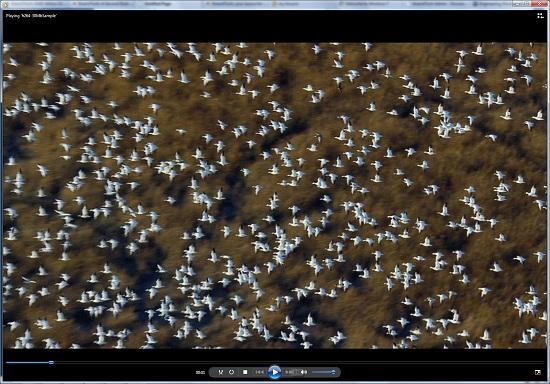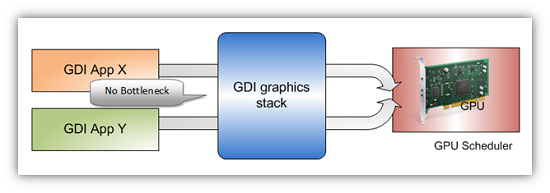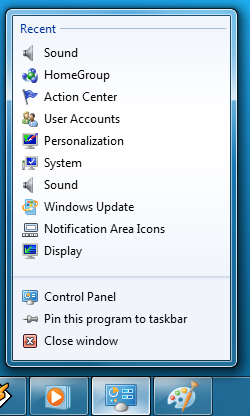Windows 7 Performance Guide
by Ryan Smith and Gary Key on October 26, 2009 12:00 AM EST- Posted in
- Systems
Feature Recap
As we have already covered the bulk of Windows 7’s new features in our look at the Windows 7 Release Candidate, we’re not going to spend too much time here. If you want an in-depth look at the new features, please see that article.
Performance
Vista’s performance was something of a quagmire. Even after SP1 fixed its biggest issues, it continued to be rather RAM hungry and poorly suited for low-end computers and newly minted cheap computers with the performance of older low-end computers. Netbooks made this situation particularly problematic for Microsoft, as their limited performance amplified this issue and resulted in netbooks shipping with Windows XP almost exclusively.
For Windows 7, Windows has been put on a diet in order to perform better on those machines. The most noticeable changes here are that Windows 7 eats less RAM and hard drive space out of the box than a comparable version of Vista did. There have also been some underlying tweaks to SuperFetch (it’s less aggressive on startup) and the kernel to improve responsiveness.
Our own experience here is that Microsoft has come through on this, although whether it’s enough is going to depend on just what someone is looking for. We have a few laptops where Vista was an absolute slug while Win7 runs just as well as Windows normally does. For someone looking for Win7 to perfectly replicate XP’s performance however, they’re going to come away disappointed – you’re never going to stuff something like Windows 7 in to the performance characteristics of an 8 year-old OS that forgoes real security and predates wireless networking.
Also while these changes should percolate to higher-end computers, the impact will be marginal at best. Vista had enough going on that it could bog-down low-end hardware, but hardware that as already capable of running Vista well isn’t going to greatly benefit from changes made to squeeze more out of the low-end. We’ll see this in detail later with our benchmarks.
Media
Windows’ media capabilities have been greatly augmented with Windows 7, primarily through the inclusion of decode and encode capabilities for a number of video and audio formats. While Vista included support for MPEG-2/1 and WMV9 video, Win7 has added support for much more contemporary codecs: H.264 and MPEG-4 (A)SP. Audio support has seen the inclusion of support for AAC and AAC+ audio, commonly found as companion audio streams for H.264 video, streaming internet radio, and portable media players.

Windows Media Player playing a 30Mb H.264 clip entirely in software without breaking a sweat
This gives Windows 7 the ability to play just about everything entirely out of the box, forging the need to deal with codec hell. The only notable things missing here are support for BluRay playback (you’ll need separate software), and some media container types (OGG, Matroska, MOV).
Encode support has been added for H.264 video and AAC audio through the Media Foundation Transcode class. This gives Win7 the ability to encode video on the fly for loading media on to portable media players and streaming to other devices (e.g. DLNA). However the use of this feature is quite limited at this time; only a handful of media players support the level of integration with Windows required to use the encoder. iPods need not apply.
Meanwhile Windows Media Center has seen its own improvements on top of the benefits it derives from greater codec support. At a high level this is a general UI touchup. At a low level this includes adding support for ClearQAM cable tuners, and the user-installation of CableCARD tuners.
Graphics
Windows 7 also brings about some additions to graphics capabilities. The headliner here is DirectX 11, whose introduction is being timed with the launch of Windows 7. DX11 is being released on Vista too any day now, so this is by no means an exclusive feature, but given the timing, it’s one of importance. We’ve already seen AMD launching their 5700 series and 5800 series ahead of Windows 7, so that they can have DX11-supporting cards on the shelves for this launch.
Windows 7-specific changes include the addition of WDDM 1.1, which is a minor update to the video driver stack for better memory utilization. This is accomplished by keeping the texture for a window (when using Aero for desktop composition) solely in VRAM instead of keeping a copy in local system memory too. WDDM 1.1 also brings support for heterogeneous display adapters, something Vista took away.
The GDI graphics stack has also been tweaked for performance reasons. Previously only a single application could write to it at once, making GDI writes a bottleneck. The stack has been changed so that now it’s the responsibility of the GPU to schedule multiple writes, rather than having an application blocked. We haven’t been able to find any performance cases where this is of help, however.

Images courtesy Microsoft
Low-Level
While Windows 7 is not the sizable overhaul of Windows that Vista was, it still has a few low-level changes. The biggest change for users is the official support for the TRIM command for SSDs, which will improve SSD write performance without the need for manual refreshes. The kernel’s dispatcher lock has also been rebuilt for better scaling; previously it effective topped out at 32 cores, now it scales to 256 cores. This will be more felt on the server branch, Windows Server 2008 R2.
Windows XP Mode
Primarily targeted at business users, Microsoft has officially added a derivative of their VirtualPC virtualization technology to Windows 7 in the form of Windows XP Mode. Windows XP Mode is a pre-configured Windows XP Pro virtual machine for running applications that just won’t run natively under Win7, allowing businesses to half-step to Windows 7 as part of a longer transition. It comes as a separate download available for Win7 Professional and higher editions, and no, it doesn’t run games.
Interface
The bulk of the changes in Windows 7 are going to be things that you can see, literally. Various interface elements have received drastic overhauls, and at the risk of slighting all of the other groups at Microsoft, more work appears to have been put in here than anywhere else.
Chief among these is the near-total replacement of the taskbar. The new Win7 taskbar is much closer to Mac OS X’s dock in appearance and function. Active applications appear on the taskbar as just large(r) versions of their application icon, and icons can be pinned in place so that they can be launched from the taskbar in the future, not unlike the old Quick Links feature. Undoubtedly, this is going to be the hardest thing for new users to get used to, although it’s certainly not hard to grow accustomed to.

The Control Panel Jump List
Along-side the dock taskbar are jump lists, which are replacing the normal right-click menu for items in the taskbar. Jump lists contain application specific commands, standard window manipulation commands, and recently used files for the application in question. Applications need to be coded to make full use of jump lists.
Also added are a pair of new Aero gestures. Aero Snap causes an application to be maximized when it’s dragged to the very edge of a screen, and returned to normal when dragged away. Aero Shake minimizes all other windows when a window has been shaken. Microsoft’s Rolodex-wannabe Flip3D is still here, much to our chagrin.
Other notable changes include gadgets, which have been liberated from the sidebar in order to reside on the desktop, and the classic Start Menu, which has been terminated entirely in favor of the Vista (and later) Start Menu. Finally, the whole default color scheme of Windows has been redone; pea green is out, blue/grey is in.
UAC
Finally, User Account Control, the fundamental underpinningsof Vista’s enhanced security, has also seen an overhaul. By reducing the integrity of UAC slightly so that by default it auto-elevates signed Microsoft programs, Microsoft hopes to reduce the perceived annoyance of UAC without compromising the actual security. As a result, UAC should be less noticeable, particularly when first setting up a computer. However there are possible security consequences of this, which we’ll get in to later











207 Comments
View All Comments
Voo - Friday, October 30, 2009 - link
That's strange.. I just tested it and it neither updates progress in my VM, nor does it show anything if I'm looking a video in FF.Maybe the windows internals like file copying or similar things, but definitly not everything
Win7 Professional x64.
rs1 - Friday, October 30, 2009 - link
Here's a quick screencast that shows the window preview updating in realtime, for both Firefox+Youtube, and the Windows Task Manager:http://goview.com/?id=3c96284e-ba48-475e-a314-d8ef...">http://goview.com/?id=3c96284e-ba48-475e-a314-d8ef...
...the only time I can get the preview to *not* update in real-time is when I have explicitly minimized the window I want to preview. I practically never do that in Win 7, because the improved taskbar makes it really unnecessary (which is probably why I never noticed the cases where the preview would not be updated).
Voo - Saturday, October 31, 2009 - link
Ah that's it - I virtually always minimize my windows, so I never noticed the different behaviour.Yep if you don't minimize the window explictly you get the realtime preview, didn't know that.
coachingjoy - Wednesday, October 28, 2009 - link
While obviously a corraborative effort this article is well balanced and a good read.The authors are windows users but are not fanboy-ish in their observations.
Well done.
vistakah - Wednesday, October 28, 2009 - link
Every time windows releases a new version the naysayers go " I WILL NEVER UPGRADE!" Their loss i suppose. Window XP was a great OS. Was it as good as Vista? Not at all as long as you had the hardware to support the OS. No dated systems would not run it and that was its downfall. I built a system for Vista and i had no issues at all with it at release. Windows 7 is much improved with some cool new things. Sorry i like the coolness factor in computing. The only difference between installing Windows 7 and Vista other then 7 was much faster was that every piece of hardware had W7 drivers already.Everything on my computer worked at first boot to include my wireless hotspot. Mac can still waste their money on TV commercials. We live in a PC world that will and Mac like Linux will just be small time which is ok as an option. MS did a great job this time as far as i can tell.
yyrkoon - Wednesday, October 28, 2009 - link
Compared to XP, Vista was an abortion. Vista may have had an updated Architecture, and things like UAC ( I actually like UAC; it really is not all that intrusive ). But everything that was supposed to make Vista better was not working, or was not functioning correctly. Just as one example, the new TCP/IP stack was supposed to increase Gigabit networking performance. Instead, it made it worse.Then, you have processes like the trusted computing process that can not even be disabled without all but disabling the operating system. The OS will run, but you can not doing anything with it other than look at it. Microsoft, and its partners have no right to tell us what we can run, and when. No matter if it is illegal, or not. That is a mater for our individual governments . . . to govern. And yes, I have found at least one legitimate reason to have this process disabled.
However, on the other hand it is not all that terrible. At least not as terrible as all the BS spread all over the net. Likenesses made to Windows ME are purely absurd. It is functional, and it is stable, and hell, it technically is more secure out of the box. That is for users who have no clue.
I personally only use Vista because a laptop I bought came with it. Eventually I will retrograde to Windows XP *only* because of the gaming performance difference. You know what though ? I Beta Testes Vista since the beginning, I know Windows XP ( Pro ) very well, and I *know* what I want. Does this make Windows XP less secure ? Not for me, but *your* millage may vary.
Pay attention to what you're doing folks . . .
yyrkoon - Wednesday, October 28, 2009 - link
Windows7 AND Vista *BOTH* outperforming Windows XP in Directx 9 titles . . .? Something tells me someone, or something is not right. I had done all my own testing from Vista Beta, to RC, and it was *ALWAYS* slower in Directx 9 games compared to XP. Even if only by a frame or two a second. A lot were 7-10 FPS slower. Right now, I am playing a 5 year old + game in Vista that constantly stutters . . . Something that ran fine on current hardware 5 years ago.It would not surprise me if Video card manufactures are doing something to their hardware, and / or drivers. It is not like this sort of thing has not happened in the past. Maybe, it is just a matter of implementing new technology, that just happens to work with the newer OSes. But I doubt it.
The network performance increases are something that were *supposed* to come with Vista, and honestly annoys me more than impress. Only because I had to wait for the next iteration of Windows to see this improvement come to pass(and it really is not that huge of a difference really). Throughput figures would have been nice, instead of a timed test. The new TCP/IP stack is supposed to be there, as well as a load of other architectural improvements . . . but nothing improved between XP and Vista ( actually got worse ).
Now I have to say that security has never been an issue for me in Widnows XP. Then again, I am not some idiot, clicking yes on every dialog that pops up in my browser, or doing other equally stupid things. Any system is only as secure as the user using it. Period. Arbitrary code can be run on *ANY* system were the user is ignorant. There are many Linux boxen that have been rooted, and Linux has a much more robust kernel architecture. The difference here however is that these machines were mostly highly visible as servers. My point here is; Do not blame the OS, blame the user / administrator. Vista, or Windows 7 may be more advanced compared to XP, but they pale compared to Linux/Unix.
Lastly, I would like to dispel the belief that computers automatically get infected just by connecting to the internet . . . Downloading illegal ( and virus ridden ) software, visiting porn sites, and opening emails from people you do not know ( or even those you do know ) I would have to put high on the list of ways to become compromised. Joe hacker ( Joe script kiddie ? )may be looking for a way to compromise any number of highly visible servers for numerous reasons, but he has no idea who Joe blow even is. Let alone what Joe Blow's IP is. Even if he did, he would have to find a way to connect, which is virtually impossible on a hardened system. So sure, perhaps Windows compared to Linux, or any other Unix like operating system ( this includes OSX ) is architecturally inferior in this respect; It still can, and does happen to any operating system. But not *_just_because_* you've connected to the internet.
Torment - Wednesday, October 28, 2009 - link
"Lastly, I would like to dispel the belief that computers automatically get infected just by connecting to the internet"
Hahahahaha...Sasser? Blaster? Are you really that clueless?
Beyond the network security holes those exposed, browsers need to be sandboxed. Period. It would solve 99% of the virus/trojan/malware problems home users experience.
yyrkoon - Wednesday, October 28, 2009 - link
Are *you* really that clueless ? Seriously.*IF* you let your system respond to IDENT, then *maybe*. However, this is *not* just because you connected to the internet. This is because you connected to the internet, Joe Hacker was looking to exploit you(and others), and because "you" did not harden your system. Browsers have nothing to do with this matter per se. What does have to do with this is getting an executable on a machine in hopes of exploiting it. Using Internet Explorer was just a means to accomplish that end.
Now do you care to know how Sasser was caught ? Those of us who *know* which processes are running all the time, and that 99% CPU utilization is far from expectable most of the time. e.g. those of us who know what processes we run, and how much CPU we *should* be using at any given time / situation.
Still, this really is not that much different from exploiting Apache on a Linux server. Only difference is delivery ... only. Now *if* Apache were sand boxed . . .
By the way, many of *us* were never affected by Sasser. That is, those of *us* who pay attention.
Torment - Thursday, October 29, 2009 - link
And what were XP's settings out of the box? And how many people were infected by just those two? Dumbass.My point about sandboxing IE was apart from the previous point. In my experience, it is the primary vector for infection. And there have been exploits that allowed infection when visiting "safe" sites that had been compromised by yet another security flaw. If browsers were sandboxed, 99% of problems would be solved. Microsoft is slowly moving in that direction.